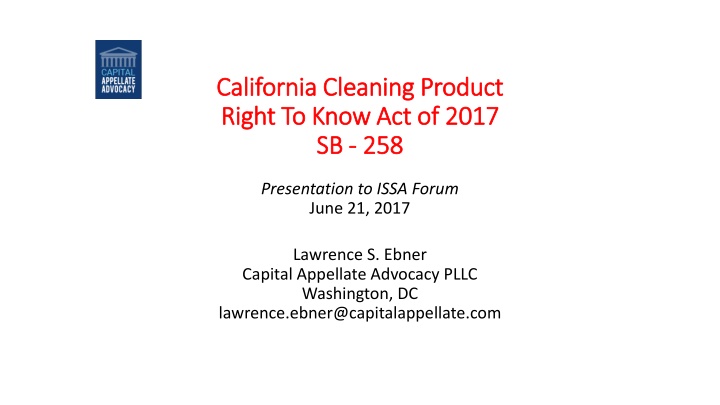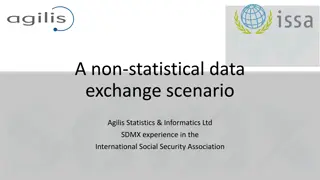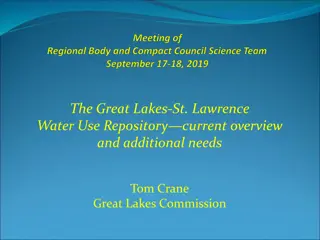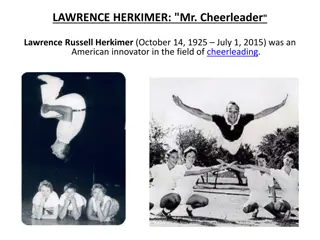
California Cleaning Product Right To Know Act 2017
Explore details about California Cleaning Product Right To Know Act of 2017, requiring disclosure of cleaning product ingredients to protect consumers and the environment. Learn about the purpose, proponents' rationale, and definitions related to cleaning products.
Download Presentation

Please find below an Image/Link to download the presentation.
The content on the website is provided AS IS for your information and personal use only. It may not be sold, licensed, or shared on other websites without obtaining consent from the author. If you encounter any issues during the download, it is possible that the publisher has removed the file from their server.
You are allowed to download the files provided on this website for personal or commercial use, subject to the condition that they are used lawfully. All files are the property of their respective owners.
The content on the website is provided AS IS for your information and personal use only. It may not be sold, licensed, or shared on other websites without obtaining consent from the author.
E N D
Presentation Transcript
California Cleaning Product California Cleaning Product Right To Know Act of 2017 Right To Know Act of 2017 SB SB - - 258 258 Presentation to ISSA Forum June 21, 2017 Lawrence S. Ebner Capital Appellate Advocacy PLLC Washington, DC lawrence.ebner@capitalappellate.com
Bill Summary: SB 258 requires cleaning product manufacturers to disclose specified information about the chemicals contained in the products on the product label. The bill applies to all cleaning products manufactured or sold in the state on or after January 1, 2018. Purpose: Full ingredient disclosure to protect consumers, janitorial & domestic workers, and the environment 2
Proponents Rationale Proponents Rationale Cleaning products contain thousands of chemicals, many of which have been associated in scientific studies with cancer, asthma and other respiratory damage, skin allergies, and reproductive, developmental, and hormonal changes Ingredient labels are mandatory for food, retail cosmetics, and drugs, but not for cleaning products [what about disinfectants??] Existing federal and California laws do not require cleaning product manufacturers and distributors to fully disclose ingredients on product labels Californians have the right to know exactly what they are buying in the cleaning aisle The Act will require companies to come clean about their ingredients so California families, domestic workers, and vulnerable populations such as children, pregnant women, cancer survivors, and individuals with health conditions and chemical sensitivities can make informed decisions and choose products that suit their needs 3
Definitions Definitions Cleaning product means any product used primarily for commercial, domestic, or institutional cleaning purposes, including an air care product, automotive product, general cleaning product, or a polish or floor maintenance product General cleaning product means a soap, detergent, or other chemically formulated consumer product designed or labeled to indicate that the purpose of the product is to clean, disinfect, or otherwise care for fabric, dishes or other wares, surfaces including, but not limited to, floors, furniture, countertops, showers and baths, or other hard surfaces, such as stovetops, microwaves, and other appliances Chemically formulated consumer product means a consumer product, as defined in [Health & Safety Code 25251(e)] a definition which excludes pesticides 4
More Definitions More Definitions Ingredient means a chemical that has a functional or technical effect on the product, including, but not limited to, the components of fragrances and coloring agents Contaminant of concern means a chemical present in the product at or above the practical quantitation limit that has no functional or technical effect in the finished product and is included on the California Department of Toxic Substances Control (DTSC) Candidate Chemicals List due to a hazard trait or toxicological/environmental endpoint, or is an allergic fragrance that appears on the list in Annex III of EU Cosmetics Regulation 1223/2009 5
Key Requirements Key Requirements Manufacturers of cleaning products sold or produced in California after July 1, 2018 must disclose each ingredient and contaminant of concern on the product label Ingredients & contaminants of concern must be listed in decreasing order by weight (ingredients present at < 1% can be listed in any order) Labels must include a pictogram developed by the California EPA that communicates the potential health impacts of any of the ingredients or contaminants of concern in the product 6
Key Requirements Key Requirements (cont'd) cont'd) Labels must direct consumers to the manufacturer s website, which must disclose all ingredients & contaminants of concern and provide links to the DTSC & EU Cosmetics lists Requires an employer to identify a cleaning product & its ingredients on workplace containers 7
Some Issues Some Issues Practicality of listing each ingredient & contaminant of concern on product labels Practicality of including Cal EPA pictograms on product labels Information overload & over-warning Regulatory overlap FIFRA labeling issues for disinfectants FIFRA preemption of state labeling requirements EPA policy re websites as labeling 8
Status of SB 258 Status of SB 258 February 2017 Introduced by California Senator Ricardo Lara (a powerful, liberal, Democrat from LA) March 2017 Considered by California Senate Committees on Labor & Industrial Relations and Environmental Quality May 2017 Considered by Senate Appropriations Committee (Lara is chair) May 2017 Passed California Senate by 22-15 vote primarily along party lines; sent to Assembly June 2017 Referred to Assembly Environmental Safety & Toxic Materials and Labor & Employment Committees 9
Bristol Bristol- -Myers Squibb Co. v. Myers Squibb Co. v. Superior Court of California Superior Court of California No. 16 No. 16- -466 (U.S. Supreme Court) 466 (U.S. Supreme Court) Presentation to ISSA Forum June 21, 2017 Lawrence S. Ebner Capital Appellate Advocacy PLLC Washington, DC lawrence.ebner@capitalappellate.com
Issue Issue Can out-of-state plaintiffs file product-liability suits in California state courts even though the defendant manufacturer or distributor is not at home in California? From a legal viewpoint, the issue involves jurisdiction the power of a court to hear a case & a defendant s constitutional right to due process From a practical viewpoint, the case involves the ability of plaintiffs lawyers to engage in forum shopping from industry s viewpoint, the California state court system is considered to be one of the worst judicial hellholes in the United States 11
Case Background Case Background Product liability litigation involving Plavix brand-name prescription drug to prevent blood clots & strokes Plaintiffs are 86 California residents & 575 non-California residents from 33 other States The non-California plaintiffs were not prescribed Plavix by a California doctor did not buy or take Plavix in California suffered no alleged injuries in California 12
Case Background Case Background (cont'd) Defendant Bristol-Myers Squibb is not incorporated or headquartered in California did not research, develop, or manufacture Plavix in California But: does have unrelated research facilities & sales personnel in California did conduct a nationwide advertising campaign for Plavix did sell Plavix in California through a distributor 13
Case Background Case Background (cont'd) Divided California Supreme Court held based on a sliding-scale approach which gives weight to a company s unrelated in-state activities that the California trial court had case-specific jurisdiction to adjudicate the out- of-state plaintiffs claims U.S. Supreme Court agreed to hear the case United States participated as amicus curiae in support of Bristol- Myers Case was argued on April 25 Supreme Court s 8-1 opinion issued on June 19 in favor of Bristol-Myers 14
SUMMARY OF OPINION SUMMARY OF OPINION Existing specific jurisdiction principles control the outcome of the case There must be a connection between the out-of-state plaintiffs claims and the forum State When there is no such connection, specific jurisdiction is lacking regardless of the extent of a defendant s unconnected activities in the State (slip op. at 7) California Supreme Court s sliding-scale approach resembles a loose & spurious form of general jurisdiction, under which a company can be sued by anyone in the State where it is at home 15
SUMMARY OF OPINION (contd) SUMMARY OF OPINION (cont d) Justice Sotomayor, sole dissenter, concerned that [t]he effect of the Court s opinion today is to eliminate nationwide mass actions in any State other than those in which a defendant is essentially at home. (slip op. at 10 (Sotomayor, J., dissenting)) Court s eight-Justice majority states that its decision will not result in the parade of horribles that [plaintiffs ] conjure up (slip op. at 12) 16
SIGNIFICANCE OF OPINION SIGNIFICANCE OF OPINION Nationwide marketing activities or even high volume of sales in a particular State is not enough for a company to be sued by out-of- state plaintiffs in that State if it is not where the company is at home at home normally is only where the company is incorporated or has its principal place of business 17






















